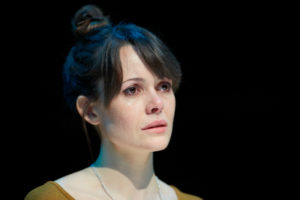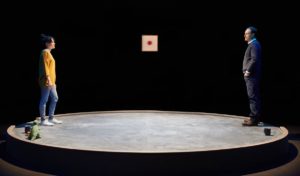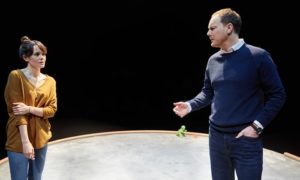Brad Birch’s new play Tremor follows Tom and Sophie, former lovers and trauma survivors, as they reconnect years after the cataclysmic event which split them apart. We watch as the titular tremor of trauma continues to flay and fragment Sophie and Tom’s fractured, dormant relationship, as well as their own psyches, during a straight-through, seventy-minute emotional roller-coaster ride that expertly manipulates our understanding of events, and with whom our sympathies lie.
Being the only two actors onstage, Lisa Diveney and Paul Rattray have the unenviable task of navigating the muddy waters of their supremely complex characters as well as engaging the audience without the use of props, detailed sets, or other actors. Happy, then, that they are more than up to the task. You feel these characters know each other, but how? When? Why did they separate? These questions are all addressed by the end, but our interest in finding the answers is down to the script, and the actors’ skilful interpretation of it.
The audience’s perception of the characters, and their perception of each other, shift constantly throughout the engaging seventy-minute runtime. Lisa’s unexpected arrival at Tom’s new home is the re-opening of a wound, but the exact nature of the laceration is only revealed towards the climax. The meatier role of Tom has the tendency to tip into hyperbole, though Rattray does well not to lapse into megalomania, portraying a very believable kind of badness that permeates the realms of the personal and the political.
Diveney’s performance is perhaps the stronger of the two, partly because she represents the far more reasonable standpoint, and partly because she weaves intrigue and nuance more subtly; mesmerising throughout in a subtly tricky role, Diveney proves herself a captivating stage presence, and certainly one to watch in the future.
Tremor is essentially a power play between two highly unreliable narrators. Its genre shifts from post-break up meet-cute to an acute discussion of trauma, to a legal case dissected long after the fact, to a full-on horror story. But there’s no Freddy Kruegers or Jason Voorhees on the stage; rather, what we are confronted with is a very human brand of evil, the kind by which we are surrounded on all sides in our increasingly fraught political climate. The mystery and intrigue drive most of the early action in particular, and David Mercatali deftly directs the actors into weaving a murky tale of interpersonal strife that carries the play from the tentative awkwardness of a long-separated couple reconnecting, right through to the dark denouement.
The stage, designed by Hayley Grindle, is the barest of settings; a circular plinth which resembles the moon, the earth, the cyclical nature of trauma which plagues the two major, and only, characters who physically appear in the play. There are three props, two of which will be discussed a little later, but they do little to distract from the otherwise spartan stage. The third prop is a painting; a colourful, scrambled scrawl that makes one increasingly anxious the longer one gazes into its tangled depths. The chaos on canvas effectively externalises the tangled web of trauma both within and between our two characters. The sparseness of set is evidently a purposeful choice; no props means no distracting from the drama unfolding between the characters. It also lends the story a metaphysical, almost fantastical quality. As such, the lighting and sound, by Ace McCarron and Sam Jones respectively, has to work overtime to underline and enhance the dialogue-driven dramatic shifts, which both do to subtle, sinister success.
I was privileged to once again be a speaker on the post-show panel, led by Timothy Howe, Sherman’s Communities and Engagement Coordinator, along my co-panellists Matthew Holmquist (Tremor’s Assistant Director) and Dr Alena Drieschova (Lecturer in International Relations, Cardiff School of Law and Politics). The discussion was as intriguing and engaging as always, with some fantastic insight from panellists and audience members alike. One of the audience members spoke about her experiences as a visibly Muslim woman living in the UK, and found the discriminatory realities of her own life being reflected in the events of the play. Despite its expressed focus on the relationship between two traumatised characters, the play’s socio-political dimensions, channelled and expressed through its protagonists, certainly appears to be its most successful innovation.
As well as portraying examples of post-traumatic stress and interpersonal drama, it is impossible not to read Tom and Sophie as manifestations of two distinct socio-political archetypes. Tom could be read as representing toxic masculinity incarnate; a man who twists his trauma in order to express his latent bigotry. Conversely, Sophie could be read as representing the more liberal left, specifically the kind of person who would have participated in the various global marches against the rising conservatism of recent years. Her entire raison d’être during the latter acts of the play is to act as witness, advocate and legal defender for the voiceless defendant. Sophie rightly points out how the defendant, a Muslim man, was a victim of institutional racism – but despite this, we still have two white people discussing the case, whilst denying the Muslim character the same opportunity; indirectly refusing him a voice, an opportunity, and a stage on which to defend himself.
And now for a little discussion on duality from your friendly neighbourhood Doubles researcher. Sophie and Tom could be read as fragmented parts of a singular person, separated into the ego and the id, with Tom as the Hyde to Sophie’s Jekyll. Tom can be read as the primal self, the monstrous extreme, who manifests and reflects humanity’s dark side, the kind you find writ large in tabloid newspapers and certain presidential twitter feeds. Sophie, on the other hand, is the rational self, who calls out Tom for his racist views and actions, and who tries to use her privilege to fight for those who aren’t born with such a societal luxury. As such, the play just scratches at the surface of interrogating the shifting landscape of identity, both personal and national, through the characters of Sophie and Tom, although the narrow scope and reduced cast meant that we lost out on a wealth of diverse perspectives on such a broad, knotty topic. And from a Law and Literature perspective, the play gives laypeople the stage, both literally and figuratively, to discuss and dissect legal issues through the medium of literature, foregrounding emotion and empathy over technical legal analysis.
I did promise I’d get to the other two props; the props in question, such as they are (the actors only directly interact with them once), comprise a pair of duelling dinosaurs, children’s toys that face each other confrontationally, poised to strike at any moment. At first, I assumed they represented the children that Sophie and Tom may have lost in the crash, but we later learn that this is not the case. Their trauma stems from their own physical and emotional pain, rather than from the loss of a loved one. And so, over the course of the play, those two seemingly innocuous prehistoric playthings lost their innocent façade and seemed to become more confrontational and more monstrous with each passing moment. Their transformation is certainly reflected in the shifting personas of their human counterparts, certainly in terms of opposing moral viewpoints, though only one character emerges as a true monster.
As the post-show panel came to a close, one thought struck me as I left the room: there can be no justice, only closure. With such a complex legal, personal case, how can it truly be said that justice is done? People died, a man was punished; but he did not receive a fair trial, lies indicted him, and the prosecution expertly manipulated societal prejudice that made him a scapegoat. Though Sophie wants closure for herself and the other victims of the crash (including the man responsible for it), what she truly wants from Tom is a confession, an admission of his guilt in prolonging their trauma and perpetrating prejudice. She gets it, in a way; but Tom transfigures it into a rallying cry for racists. Sophie’s answer to his offer remains a mystery, the abrupt cut to black denying us the closure of her response. But for all of us gathered there in the audience, Tom’s cruel climactic call was unanimously, and cathartically, rejected. Emotionally intriguing and utterly gripping, Tremor wades through the dichotomous mire between a person’s true self and the mask they wear to conceal it.






Excellent review. I was left a little less enthusiastic about this play, but your criticism is persuasive and informed.
Thank you for such a lovely response, Roger!